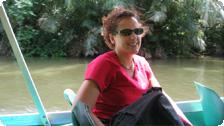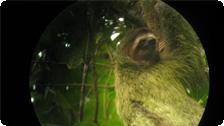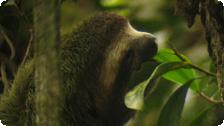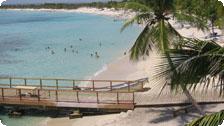Wellness: Costa Rica: In Search of Sloth, the Sweetest Sin
by Jennifer Anthony
Many travelers venture to Costa Rica to see the troupes of monkeys, the fine-billed toucans, the Technicolor parrots, the beetles large enough to leash, or the dentally daunting crocodiles. I won’t deny that I oohed and ahhed along with everyone else when I saw some of these marvelous creatures.
But even before I’d touched down upon Costa Rican soil, I’d fallen hopelessly in love with the charming mug and countenance of the two-toed and three-toed sloth. As I set out on the trip, my neck ached from stress; puffy bags had risen under my eyes from lack of sleep. The life of a sloth was appealing.
The three-toed sloth’s Latin name is Bradypus variegates; the two-toed’s, Choloepus hoffmanni. But of course, few go to such syllabic and scientific lengths—it’s much easier to refer to them collectively, as one of the seven deadly sins, in English a laze and in Spanish un perezoso. Either way, a rather bad rap.
A fellow traveler had the following human-centric quip to say about the sloth: “They’re cute, but really, what biological purpose do they serve?” And indeed, it is true that the creature does sleep an average of fifteen hours per day. But this is not laziness; instead, it’s a way to preserve energy from a limited food intake.
Sloths move infrequently and three-toeds shift from sun to shade as a form of thermoregulation. This, combined with a narrow home range and the fact that the animal only descends from the tree canopy every eight days or so to use the forest’s facilities, results in a creature that leaves a rather small footprint, or shall we say, clawprint, on the earth. What a concept.
My first sighting of the diurnal three-toed sloth was in Manuel Antonio National Park, a reserve replete with animals and beautiful beaches on the country’s Pacific coast. Our visually gifted guide Hamhar stopped short, set his immense telescopic lens on the ground, and focused in on a fine male specimen.
Sloths don’t squawk, or chirp, or bellow. They don’t growl, or pounce, or fly through the trees. They hang out, very quietly, and—if the onlooker is lucky—they might slowly reach for a leaf or two to munch. When this particular sloth glanced down at us with his Mona Lisa smile, I realized that the animal had everything all figured out. I noticed Hamhar regarding the sloth with sincere respect, and saw that I wasn’t the only one who’d fallen in love.
Another three-toed sloth was spotted by Brian, a tour guide in Fincas Naturales, a thirty-acre private nature refuge/conservation project on the road between Manuel Antonio and Quepos, also home to numerous animals, a butterfly conservatory, and a space that will soon host an orchid garden. Brian set aside his telescopic lens, and, bare-eyed, pointed out a sloth napping high up in a tree. He explained the sloth’s eating habits, how preferences for a few tree species appear to be matrilineal. He shared the various insectile uses of the sloth’s dung, thereby addressing that irksome biological purpose question.
Brian recalled with affection how he’d once found a three-toed sloth in the middle of a soccer field, ragged from the heat, and given him a lift to the trees. He added how he would never have done this if it had been a two-toed sloth.
I had to stop him at this point. I knew two-toed sloths were nocturnal and thus harder to spot, but didn’t there seem to be a little three-toed favoritism? Bryan reassured me that this was not sloth prejudice; he simply wouldn’t have done it because he had found that two-toeds are a bit more skittish when held by humans.
Just two nights later, during dinner at the Mono Azul hotel’s Rainforest Restaurant, the proprietor approached the table. Sorry to interrupt, she said, but if you’d like to see a two-toed sloth, one is resting in the tree just outside. Several people scrambled to the garden, squinting to see in the dark, blinking in the pouring rain. There above us nestled a round, motionless ball of fur, impervious to the deluge.
The owner explained how they had rescued a few sloths in the past and released them back into the wild; if he were one of them, he would respond to her. She called out; the sloth didn’t flinch. Not to worry, she explained. He will probably still be here tomorrow and will be easier to see in the daylight. Sure enough, the sloth was there the next morning, in that same hunched position, heedless of our little whistles and calls for attention.
The next two days were packed with adventure: zip-lining one day, and horseback riding the next. The first event offered a tour of the rainforest’s canopy along nine zip-lines and three rappels; the latter, the earth below it. Neither activity resulted in any sloth sightings; we were moving much too quickly to spy the well-camouflaged critter.
I would not see another sloth until Tortuguero National Park, a remote reserve on the country’s east coast whose canals run parallel to the Caribbean Sea like frontage roads. The area can only be reached by airplane, soaring above the broccoli-esque canopy of trees, or by boat through the canals. The payoff for the long trip is a chance to experience the waterways teeming with wildlife, and a surreal nighttime visit to the beaches where thousands of enormous green sea turtles emerge from the sea between May and October to lay their ping-pong-ball-sized eggs.
The trip also affords the traveler the opportunity to visit one of the small towns such as Tortuguero, to see the Caribbean influence on the country, and to stay in a place such as the Tortuga Lodge, where, like Fantasy Island, the manager greets guests at the dock with warm hellos and frothy fruit drinks.
On the ride out to the lodge, Ricardo, the guide, cut the engine and the boat drifted over to the canal’s banks. Above us hung a three-toed sloth, in a blur of slow-motion activity. He moseyed up the tree limb, eying us from time to time, his wide brown eyes blinking, his sly smile unwavering. Never before had I been so excited to see an animal moving so slowly. He paused and mugged for the camera.
I relished my pictures of the various representatives I’d seen but wanted to supplement the snaps with some slothy kitsch. Easier said than done. The tourist shops overflowed with T-shirts, decorative tiles, and mugs hosting parrots, monkeys, iguanas, morpho butterflies, and turtles. Judging by the representation in stores, one would wrongfully surmise that the chances of seeing a jaguar or a toucan in the wild are much higher than seeing a sloth.
Was I the only one who found them so endearing? I remembered Hamhar’s adoring expression in Manuel Antonio, the way Ricardo’s eyes had softened at the sight of a fine specimen hanging above the water in Tortuguero. Surely not! But when I asked time and time again in stores—Any perezoso paraphernalia?—one by one, the salespeople would shake their heads, and attempt, in vain, to lead me to another mammal.
By the time I’d reached the Juan Santamaría airport in San José for the return flight, I’d managed to see and take several pictures of six different sloths and purchase one dusty sloth shot glass and a rare T-shirt. But I stopped short just before the gate, where an artist sat on a stool between several of his oil paintings, sketching on a piece of canvas. I glanced over, not surprised to see the usual array of toucans, parrots, monkeys, and iguanas. But there among them hung a unique painting of the sloth—two-toed, no less. Providence.
Costa Ricans, or Ticos, often use the expression pura vida, which means, in its simplest terms, that life is good, pure, unfettered. Sloths are the embodiment of this saying. To say that they are lazy is a gross oversimplification. Their lives are quiet, resourceful, pacific. They’ve evolved from elephant-sized, ice-age land mammals to smaller, peaceful arboreal beings. As much as I chuckled at the anthropomorphic image of the nocturnal two-toed and diurnal three-toed exchanging a low five at twilight, they do, in actuality, keep to themselves, rarely disturbing anything but the leaves surrounding them.
If that’s a sin, it’s a sweet one.
* * * *
In Manuel Antonio:
El Mono Azul Hotel (Manuel Antonio)
Apdo 297 Quepos, Costa Rica 6350
t 011.506.777.2572; f 011.506.777.1954
The Tortuga Lodge (Tortuguero)
t 710.8016
Hotel Kekoldi (San José)
Avenida 9, between Calle 5 and 7, diagonal al INVU, Barrio Amón
t 506.248.0804; f 506.248.0767
Transgalo Tour, S.A.
Rodolfo Alvarez Alvarez
Friendly, dependable, and ever-so-punctual shuttle driver in San José
t 483.0331
* * * *
Jennifer Anthony was born and raised in California. She has just finished her Master’s in Fine Arts in Writing for Children at Spalding University and is currently at work on a young adult novel. When she returns to Costa Rica, she hopes to visit Aviarios del Caribe, a sloth sanctuary in the southeast. In the meantime, she might just adopt a sloth from afar.
Discover more from Tango Diva
Subscribe to get the latest posts sent to your email.










